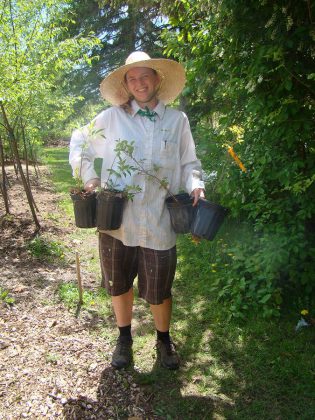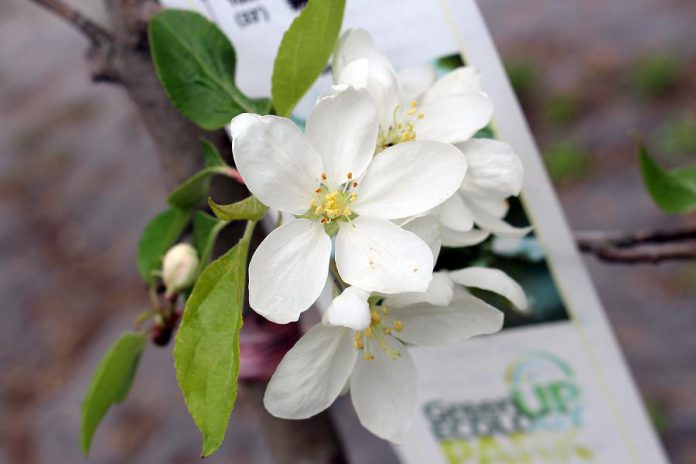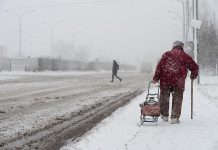
Trees are well known for improving air quality, providing wildlife habitat, growing food, and increasing property value. Their ability to combat climate change, reduce energy needs, and improve physical and psychological health is clear. Why not plant a tree this fall?
Autumn is the best time to plant a tree. It is the ideal season when the weather turns cool and, with lots of rain, soil conditions are perfect for tree roots to establish themselves.
GreenUP Ecology Park’s Little Autumn Tree Sale is this Sunday, October 16th with trees, shrubs, and plants starting at only one dollar — making it a great time to add a new tree to your yard.
Most of us have a favourite tree species that we’d like to sit under in our yard; however, it is best to understand the planting location before choosing a species to plant there. The more you know about your yard, the easier it will be to select a species that will thrive there.
Just like people, trees are particular about their living conditions. It is best to find a good match between the tree’s requirements, and the conditions present in your yard. Soil type, moisture, sun, and exposure are all important factors that will affect tree growth.
You can start by understanding the soil so that you are are able to plant species that will grow healthy roots. Is the soil heavy and wet? Is it dry and gritty?

If you don’t know much about your soil, you can look for some clues about its consistency. For example, when you water plants in your yard, does the water soak in quickly? If so, it is likely to be a sandy or gravelly soil whereas, on clay, water will sit longer and soak in after some time.
You can gain more information by digging up a small sample. Clay feels lumpy and sticky when it is wet; sandy soil feels gritty; silty soil feels soapy; and loamy soil is spongy. A handful of soil with a high clay consistency will form a shape in your hand when you squeeze it in your fist, whereas sandier soil will break apart.
Well-chosen planting locations will consider the roots, all the way up to the canopy. If the planting location is in a low-lying area that remains moist, you will want to plant a species that will thrive with “wet feet” as it’s roots will be moist for extended periods of time. Up to the canopy: how much sun will the tree receive? Some trees are tolerant of shady conditions while others are not and need full sun to prosper.
Backyards are ideal areas for planting a tree. They are often are isolated from streets, have greater space for the canopy to grow, and have deep soils to grow into. There are a variety of trees that will grow well in these tree-friendly sites; Dogwoods, Beeches, Pines, and Tamarack are species to consider.
The stresses of city life on urban trees can lead to shorter lifespans. The average life expectancy of an urban tree is only 10 to 15 years but, with attentive planning and ongoing care, trees can live longer.
Trees planted in the city are subject to built features: overhead wires, pavement, underground wires, and fences. Your planting location should consider all these factors, which can reduce the growing space both above and below ground and can affect the long-term health of the tree.
Avoid planting larger trees below wires, plant as far away from the road and sidewalks as possible, leave at least 20 feet between other trees, and be sure to request locates for underground services well in advance of planting.
With all these considerations, perhaps you’re now picturing your yard and wondering how a tree will ever grow there?
If you wish to plant near a road, have limited space near a sidewalk, or live in a new subdivision with only compacted soil to work with, you can choose a hearty species that is more likely to grow under difficult conditions. If this is the case, Honeylocust, Ironwood, or Bur Oak may be species to add to your shortlist.

Consider choosing a species that is native to our region. They have developed complex evolutionary relationships with other native species, grow well in local soil conditions, and have adapted to the area’s unique climate.
It is always beneficial to plant a diverse range of species. With a changing climate, we are able to consider planting a broader range of trees and shrubs that are now able to thrive in the Peterborough area. Planting Carolinian forest species, which typically thrive in more southern regions, allows even greater biodiversity of our urban forest. Hoptree, Kentucky Coffee Tree, and Tulip Tree are unique trees that are able to grow in sites that are protected from bitter winter winds.
Whether you are planting a tree to increase shade, attract birds, beautify your yard, grow food, or reduce flooding, there is a lot to consider.
Visit GreenUP Ecology Park’s Little Autumn Tree Sale on Sunday, October 16th from 10 a.m. to 4 p.m. to choose the right tree for the job. Sale species and prices will be available at Ecology Park on sale day only. Staff will also be on hand to help and answer your questions.
For more information, email ecologypark@greenup.on.ca.


























